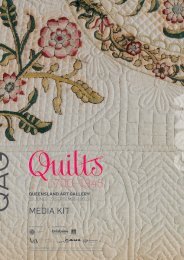Paperskin: barkcloth across the Pacific - Queensland Art Gallery
Paperskin: barkcloth across the Pacific - Queensland Art Gallery
Paperskin: barkcloth across the Pacific - Queensland Art Gallery
You also want an ePaper? Increase the reach of your titles
YUMPU automatically turns print PDFs into web optimized ePapers that Google loves.
y this crocodile <strong>barkcloth</strong> of <strong>the</strong>ir connection to people, spirit and place, and <strong>the</strong>y will<br />
be reignited. This is why it is important for Museum collections to be made accessible<br />
to communities through visits, repatriation and exhibitions.<br />
<strong>Pacific</strong> <strong>barkcloth</strong> comes in many forms, shapes and sizes, has many meanings,<br />
and plays an important part in maintaining <strong>the</strong> connections between people and<br />
place. Collections like <strong>the</strong> one held in <strong>Queensland</strong> Museum maintain a connection<br />
between people and place. They connect <strong>the</strong> people who create <strong>the</strong>se works, and<br />
<strong>the</strong> movement that continues between <strong>Pacific</strong> countries and Australia. <strong>barkcloth</strong> is a<br />
beautiful aes<strong>the</strong>tic way to show that <strong>Pacific</strong> people have a presence in <strong>Queensland</strong>’s<br />
history and will continue to have a presence into <strong>the</strong> future.<br />
Imelda Miller is Assistant Curator, Torres strait islander and <strong>Pacific</strong> indigenous studies, <strong>Queensland</strong> Museum.<br />
eNDNOTes<br />
1 Patricia Ma<strong>the</strong>r, A Time for a<br />
Museum: The History of<br />
<strong>the</strong> <strong>Queensland</strong> Museum<br />
1862–1986, <strong>Queensland</strong><br />
Museum, brisbane, 1986,<br />
pp.202–4.<br />
2 roger Neich and Mick<br />
Pendergrast, <strong>Pacific</strong> Tapa,<br />
David bateman, Auckland<br />
Museum, Auckland, 1997, p.133.<br />
36<br />
3 Neich and Pendergrast, p.125.<br />
4 robert l Welsch, Coaxing<br />
<strong>the</strong> Spirits to Dance: <strong>Art</strong> and<br />
Society in Papuan Gulf of New<br />
Guinea [exhibition catalogue],<br />
Nils Nadeau (ed.), hood<br />
Museum of <strong>Art</strong>, hanover, New<br />
hampshire, 2006, pp.23-9.<br />
5 Memoirs of <strong>the</strong> <strong>Queensland</strong><br />
Museum, <strong>Queensland</strong> Museum,<br />
brisbane, vol.2, 1913, pp.9–23.<br />
ABOVE<br />
Mask unknown<br />
Papua New Guinea<br />
Chachet Baining people, East New<br />
Britain Province<br />
Barkcloth, dye, cane / 90 x 52 x<br />
74cm / Collection: <strong>Queensland</strong><br />
Museum<br />
OPPOSITE FROM TOP<br />
Woman from Wanigela, Oro<br />
Province, Papua New Guinea.<br />
Photograph taken by Percy<br />
J. Money c.1900 / Collection:<br />
<strong>Queensland</strong> Museum<br />
Barkcloth (detail) unknown<br />
Papua New Guinea<br />
Collingwood Bay, Oro Province<br />
Barkcloth, dye / 156.8 x 45cm /<br />
Collected by Sir William Macgregor,<br />
1897 / Collection: <strong>Queensland</strong><br />
Museum<br />
37

















